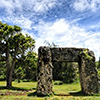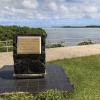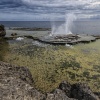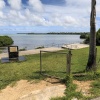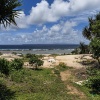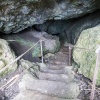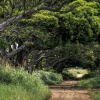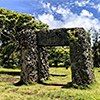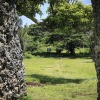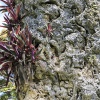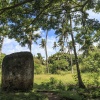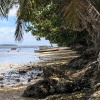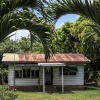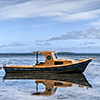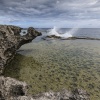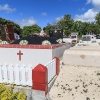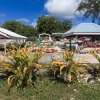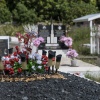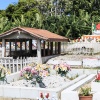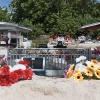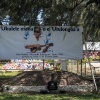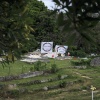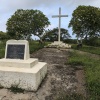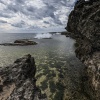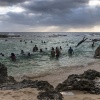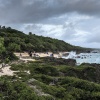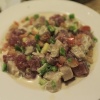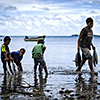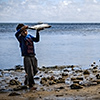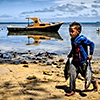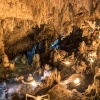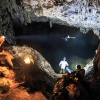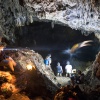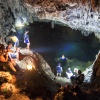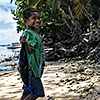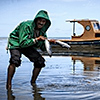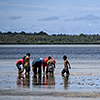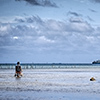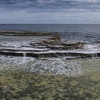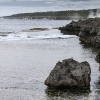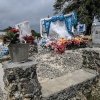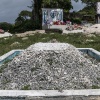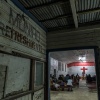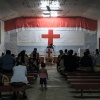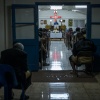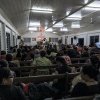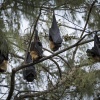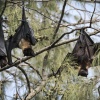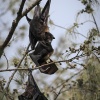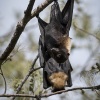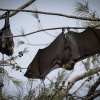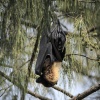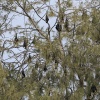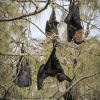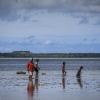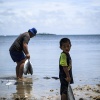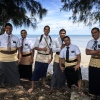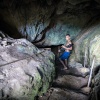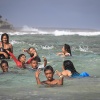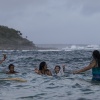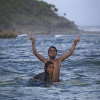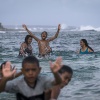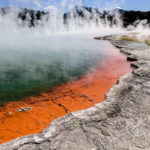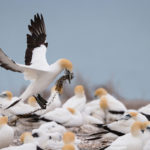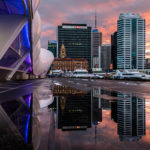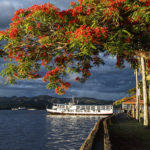Tonga – Where Time begins
What does the Island Kingdom of Tonga have in common with a high voltage cable? Correct, both things are pretty much isolated. The 136 islands of Tonga are the only Polynesian nation that never got colonialized by the west. The archipelago being called “The Friendly Islands” lies at the 10.8km deep Tonga trench, a fault where the Pacific plates submerges the Australian, which is at the same time also the International Date Line; a place where you can meet the new year as being one of the very few first people on the planet. Since the white man hadn’t his finger in the Tongan pie many unique Polynesian cultural assets like f.e. the Ha’amonga Trilithon could survive. With pleasure locals take the “palangi” by the hand and show him the island’s highlights, such as the Blow Holes, Flying Foxes or the magic Anahulu Cave, a limestone cave having a pristine fresh water pool inviting to have a swim.
It’s shortly after 7 o’clock in the evening when the stewardess opens the aircraft door. Cackling a hen guides her chicks over the run way. While leaving the 737 I literally walk against a wall of tropical humid heat, what even on the short way to the terminal building leads to immediate sweat production. I enter the airport where all passengers already queued up to get their passport stamped. The purring ventilators as well as gekkos’ clicking sweeten our waiting. The breath-taking air moisture also made the wall clock break down. Stoically it displays 5:21 o’clock yet even today.
The airport is some 20 kilometres away from Nuku’alofa, Tonga’s capital. There Ben, my host, already waits for me, a Persian having escaped from the first Gulf War and now living in the South Pacific. He is a great guy, someone joining Polynesian friendliness with the legendary Arabic hospitality. Having barely fallen asleep, a rooster thinks he’s seen the morning dawn, at 1:00 am. Its crowing makes the whole island’s chickenship being instantly on red alert. How nice…
While thinking out how the next day’s chicken barbecue could look like, the poultry slowly agrees on not having seen daylight, but it takes not much time until two or more cats start fighting like tinkers; and if there are no cats then dogs embrace literally that duty. That spectacle sees a couple of repetitions in the same as well as in the subsequent nights. Again you’re awake. Again you fall into doze. Again sleep everything finds an animal end.
To explore Tonga’s main island Tongatapu Benny lends me his car the next day urgently appealing “Never, Florian, please never park under a Coconut Tree!” The island is only some 30km wide though distances pile up quickly. My first stop is the landing site of Abel Tasman who as first European ever visited Tonga back in 1643.
Though it was James Cook who came to fame by charting the islands, establishing a connection between both nations and revisiting the archipelago a couple of years after. By naming them “The Friendly Islands” he pretty much hit the nail right on its head. Well, those sites are not really picturesque as you’ll find a memorial or a bare concrete pier only, though you can definitely feel the historic atmosphere wafting around the places.
Both, missionary work as well as the colonialisation, definitely destroyed many cultural assets in the South Pacific. One of the few and also most important remnants can be found in eastern Tongatapu, the Ha’amonga trilithon, the so called Stone Henge of the South Pacific. The arch is made of three coral limestone slabs weighting some 30-40 tons each. It is 5 metres high and got erected some 700 years ago for the same reason like Stone Henge: To observe the sky. It is definitely brill that two civilisations, not knowing each other, construct a similar tool to do the same thing. In the trilithon’s backyard a large stone named “maka faakinanga” can be found. It means “stone to lean on” and served the king’s back as protection against assassins.
While riding on the main island’s roads I often have to avoid coconut-made obstructions. Honestly, if you rush your car against one of those fruits then you have a problem. Also parking in a coconut palm’s shadow is not really what I would recommended :-) While cruising through Tonga the main island often shows another eye catcher: typically colourful Polynesian tombs. That way of worshipping the dead can be found in the whole South Pacific, sometimes being less and sometimes being quite colourfully embellished.
Having reached the main island’s eastern end, eye contact and a smile are enough to get in touch with the locals. They take my hand and show me a limestone cave, the Anahulu cave, which has got a small pristine freshwater pool inside for having a swim. Being illuminated by candles only, those nice people bestow me the first moment of real South Sea feelings. It is just fabulous to jump laughingly just for devilment from the stalagmites into the water. And you really have to be careful not to hit a stalagtite :-)
Sometimes the cave is pretty dark, making aperture 1.4 and ISO 6400 being the order of the day. Tongans are super friendly. There is no place where you run into stereotype thinking. Being a part of their life means for me to surf on a wave of cheerfulness. Being allowed to feel that positive energy is a gift of immeasurable value and light years away from the cold western way to deal with each other.
Shooting a photo without being seen? That is physically impossibile, as locals always spot the ‘Palangi’ and start to pose :-) Which is ok, as it shows that there is no fear of contact, no fear of the stranger, no fear of the photo being taken. Actually it is me who is is thankful from the bottom of my heart for having such moments, though many people express heartfelt thanks for being photographed.
Swimming and jumping the whole day makes hungry and there is no better place than „Fiesta“ on Salote Road as it has got the best seafood within the next 1000km. The local speciality is ‘Oto Ika, raw firm fish like Tuna or Marlin, being marinated in coconut milk with chilli, few garlic and assorted veggies, mostly paprika and tomatoes. A simple meal but I tell you it’s a New Year’s Eve feast…!
And then the clock slowly went towards 0:00, midnight, New Year. 99% of the Tongans flock to churches on that day and start to sing. Their voices, the melodies, their passion – all together is a breath-taking stunner moving me to tears like back in Rabaul (Papua New Guinea). That is exactly what I wanted for the New Year, far away from Berlin’s idiots walking fire-cracker driven on the edge between war and maiming themselves. I am thankful to be one of the few persons on the planet being allowed to welcome the first sunlight of a new year.
Well, the clerical way to welcome a new year is looooooong and kind of chewy. Countless speakers take the stage and rub their unstressed words into the audience like thousands of German Presidents (that is Gauck), palavering pastorally about everything and anything without getting to the point. Hence it doesn’t take much time until almost everyone enjoys a nap to cover the time between two songs. Shortly before midnight everyone’s awake though and a terrific island-wide noticeable mumbling starts as thousands of single prayers, recalling the past as well as wishes for the future, get released. That’s a vibe out of this world…
For the following days I take a bike to explore the island. “Beach Cruiser” sounds nice, doesn’t it? Well, it was literally a boneshaker as every road hump makee the saddle pool shoot right into your spine while the brakes’ reliability and force seems to be pretty much reciprocal to every kilometre being pedalled.
Somehow that two-wheeled suicide mission made it to bring me to Kolowai, in the west of Tongatapu, where in the treetops of the Tao trees, standing right next to the road, flying foxes spend the day sleeping. Already from the distance you can hear their clamour and from time to time one even flies around, though at first I missed them as they are hardly visible from the ground.
Continuing my bike ride I went to the southern village of Houma, where the near coast is famous for its Blow Holes. There the ever washing waves of the Pacific Ocean close in on the holey coast and some of the holes, the surf’s air displacement to be precise, make the water shoot up into the sky. That timeless spectacle you can watch for hours; and it surely whets your appetite for having a swim. In many places that is not possible as the coastal rocks are literally razor-sharp, hence barefoot you would ruin and slash your feet; even wearing sandals is no pleasure. Only near the Hufangalupe Land Bridge you can jump into the water, or you go to Tongatapu’s east where nice beaches wait for people.
Unfortunately British Airways doesn’t take its main business, that is passenger transport, all too serious. They shortened my Tonga adventure. I continued to Fiji, another great place in the South Pacific. That way unknowingly I took to my heels from approaching cyclone “Ian” that hit Tonga on January 11th, 2014. With wind gusts of up to 285km/h (being faster than an express train!) it belongs to the strongest ever recorded cyclones in the southern hemisphere. It wiped out some islands of the Ha’apai group.

